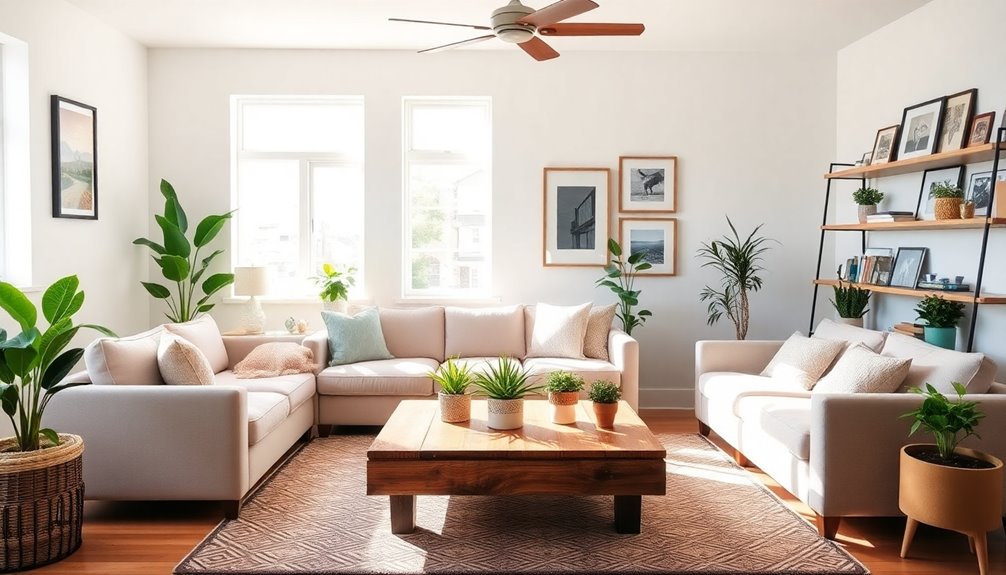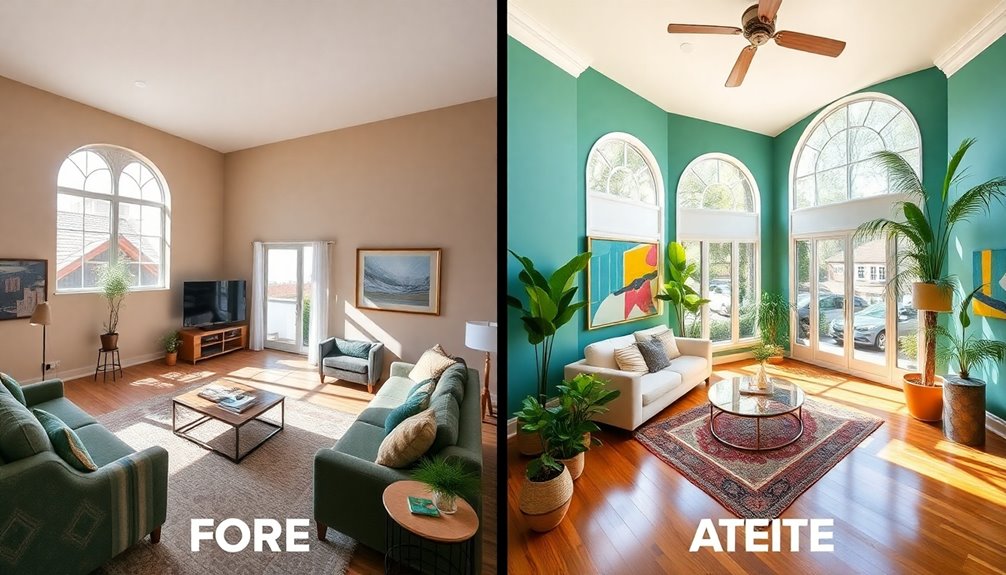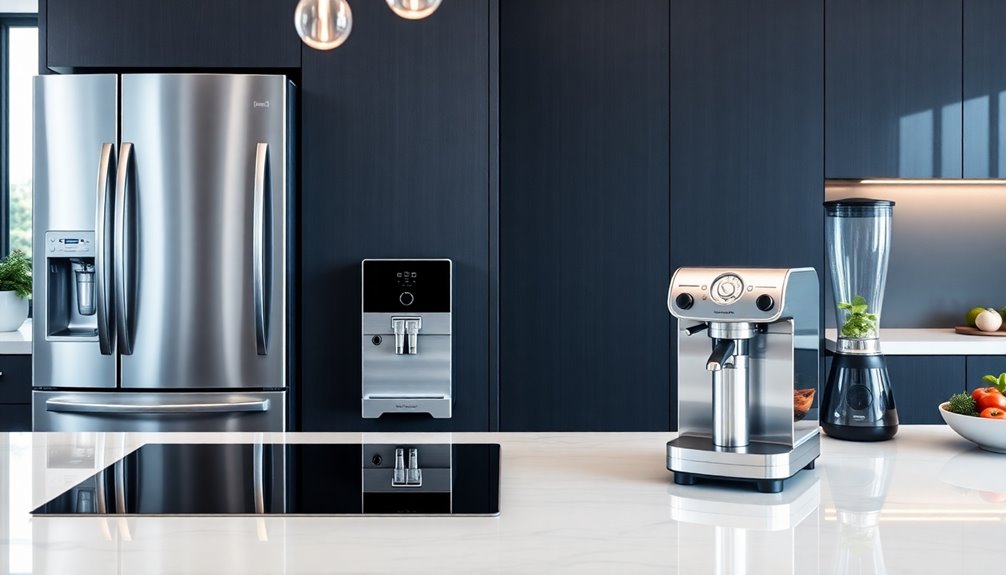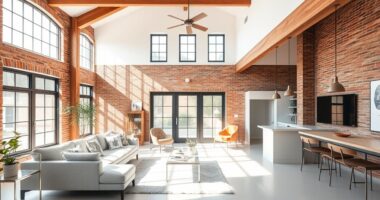To remodel like a pro, focus on a few key secrets that designers often keep quiet. Start with color psychology; warm hues energize a space, while cool shades promote relaxation. Layered lighting enhances versatility, combining ambient, task, and accent lighting for impact. Use quality materials to guarantee durability and timeless appeal. Don't forget to balance trendy elements with classic styles for lasting charm. Finally, always budget for unexpected costs to avoid headaches later. It's all about making smart choices that elevate your home, and there's a lot more to explore that can help you achieve your dream remodel.
Key Takeaways
- Prioritize quality materials over trendy items to ensure durability and timeless appeal in your remodel.
- Incorporate layered lighting techniques to enhance functionality and ambiance in different spaces.
- Utilize natural light strategically by maximizing window placements and reflective surfaces for a brighter atmosphere.
- Plan your space with zoning to create distinct areas while maintaining open flow for better interaction.
- Allocate a portion of your budget for unexpected expenses to prevent financial strain during the remodeling process.
Understanding Color Psychology

Color plays an essential role in how you experience your space, influencing both mood and perception. Understanding color psychology can transform any room into a sanctuary that reflects your personality and desired atmosphere.
Warm colors like reds and yellows bring energy and warmth, making them perfect for social areas where you want to encourage interaction. In contrast, cool colors such as blues and greens promote calmness, ideal for relaxation zones like bedrooms or reading nooks. Additionally, the concept of emotional alignment can be enhanced by selecting colors that resonate with your personal energy.
Neutrals serve as versatile backdrops, allowing other colors to shine and creating a balanced aesthetic. They work well with accent colors that highlight features and create focal points, enhancing visual interest throughout the room.
Remember, color temperature matters—warm tones can wrap a space in coziness, while cooler tones can open it up, creating a serene environment.
Research shows that thoughtful color selection affects your psychological well-being. By carefully choosing your color palette, you can cultivate a space that uplifts your spirit, calms your mind, or invigorates your creativity. Additionally, embracing a growth mindset when experimenting with colors can lead to innovative design choices that enhance your environment.
Effective Space Planning Strategies

When creating a harmonious living space, effective space planning strategies are key to maximizing both functionality and flow. To achieve this, consider the following approaches:
- Open Floor Plans: Embrace an open layout to enhance social interaction. This design creates seamless shifts between living areas, perfect for modern lifestyles. Incorporating neutral color palettes can further enhance the overall aesthetic of an open space. Additionally, the use of large windows can help to promote natural light and create an even more inviting atmosphere.
- Zoning: Define distinct areas for specific activities, like dining, lounging, and working. Zoning helps improve organization and guarantees each space serves its intended purpose.
- Thoughtful Furniture Arrangement: Arrange your furniture to promote accessibility and movement. A well-thought-out layout makes your environment navigable and comfortable, allowing you to enjoy your space fully.
- Scale and Proportion: Pay attention to the scale and proportion of your furniture and decor. Confirming these elements fit harmoniously within your space creates visual balance and enhances the overall aesthetic. Consider incorporating sustainable materials to further enhance your living space while being environmentally conscious.
Lighting Techniques for Impact

When it comes to lighting, layering your options can make a huge difference in how a space feels.
By incorporating natural light and using dimmers, you can create an inviting atmosphere that suits any occasion. Additionally, improving air quality with an air purifier can enhance the overall comfort of your environment, contributing to respiratory health and well-being. This is particularly beneficial, as HEPA filters effectively remove allergens and pollutants, ensuring a healthier living space. Furthermore, selecting an air purifier with room coverage size suitable for your space will maximize its effectiveness. Incorporating energy-efficient heat pumps can further improve indoor climate control and comfort, especially in larger areas.
Let's explore how these techniques can transform your home.
Layered Lighting Strategies
Layered lighting transforms any space from ordinary to extraordinary by incorporating three essential types of illumination: ambient, task, and accent.
This combination creates a balanced and versatile lighting scheme that enhances both functionality and aesthetics in your home. Personal influences often play a significant role in how you choose to arrange your lighting.
Here's how you can effectively implement layered lighting strategies:
- Ambient Lighting: Start with general illumination, such as ceiling fixtures or recessed lighting, to provide an overall glow. This sets the foundation for your lighting scheme. Consider using energy-efficient models to reduce electricity costs while maintaining brightness.
- Task Lighting: Add specific fixtures like desk lamps or under-cabinet lights to help with activities like reading or cooking. This guarantees you have proper visibility for tasks.
- Accent Lighting: Use statement fixtures like oversized chandeliers or unique pendant lights to create focal points. These not only illuminate but also add visual interest to your space.
- Adjustable Options: Incorporate dimmers to allow flexibility in brightness levels, changing the ambiance according to different activities and times of day.
- Air Quality Considerations: Ensure to monitor air quality indicators in your home as good lighting combined with clean air can significantly enhance the overall living experience.
Natural Light Benefits
Harnessing the power of natural light can dramatically transform your living spaces, enhancing both mood and productivity. Studies show that exposure to daylight boosts energy levels and improves your overall well-being.
To maximize natural light, consider incorporating large windows or skylights into your design. This not only reduces the need for artificial lighting but can also lower your energy costs by up to 20%.
To further amplify the benefits of natural light, utilize reflective surfaces like mirrors and light-colored walls. These elements can distribute light throughout your space, creating a brighter and more spacious atmosphere.
When strategically placed, mirrors can make small rooms feel larger and more inviting, while also reflecting beautiful views from outside.
If you want to enhance your space even more, think about the layout of your rooms. Positioning furniture away from windows allows the light to flow freely.
Dimmers for Ambiance
Dimmers for ambiance not only enhance the overall feel of your space but also save energy and extend the lifespan of your bulbs. Additionally, using dimmers in combination with wood stoves can create a cozy atmosphere while maintaining an eco-friendly home. Airless sprayers can also be used to paint the surrounding areas to achieve a flawless finish that complements your lighting design.
With various styles available, like wall-mounted and remote-controlled options, you can manage your lighting flexibly throughout your home.
Here are four ways to make the most of dimmers for ambiance:
- Create Mood Lighting: Lower the lights for a cozy dinner or a relaxing movie night.
- Enhance Functionality: Use brighter settings for tasks like reading or cooking, then dim them for leisure.
- Combine with Layered Lighting: Pair dimmers with ambient, task, and accent lights to create a versatile atmosphere.
- Increase Home Value: Installing dimmers can make your home more attractive to buyers, adding sophistication to your design.
Additionally, incorporating energy-efficient designs can further enhance your home's sustainability and comfort.
Choosing Textures and Materials

Choosing the right textures and materials is essential for achieving a well-designed space that feels both inviting and stylish. Mixing textures can greatly enhance your interiors. Pair natural materials like wood and stone with soft fabrics such as linen or velvet to add depth and visual interest. This combination creates a layered look that invites interaction and comfort. Incorporating natural elements can further promote tranquility in your home. Additionally, using high-quality materials can significantly improve the longevity of your design. Incorporating vintage furniture can also add authenticity and charm to your space.
Don't overlook the power of finishes; glossy surfaces, like high-gloss paint or polished tiles, can reflect light, making smaller rooms feel more spacious. Incorporating a variety of textures helps create a cozy atmosphere, enhancing your home's overall aesthetic.
Consider sustainable materials too. Recycled or reclaimed products not only promote eco-friendly design but also bring unique character to your space. Additionally, choosing materials made from eco-friendly and safe materials ensures that your design is safe for both your family and the environment.
When it comes to high-traffic areas, selecting durable materials—like quartz countertops or ceramic tiles—ensures longevity and resilience, making these choices a wise investment for any renovation. Textured fabrics can also add warmth and comfort, enhancing the overall experience in these spaces.
Incorporating these strategies will elevate your design, creating an environment that's both functional and visually appealing. Embrace the textures and materials that resonate with you, and watch your space transform.
Balancing Trends and Timelessness

When you're remodeling, embracing classic elements can help you create a space that feels both stylish and enduring. Investing in quality materials not only enhances the aesthetic but also guarantees your design stands the test of time. Incorporating natural materials like wood and stone creates warmth and adds a timeless charm to your decor. Additionally, using traditional textiles such as batik or ikat can infuse your space with cultural richness. Furthermore, emphasizing earthy color palettes can evoke a sense of serenity and balance in your overall design.
Embrace Classic Elements
In any remodeling project, striking a balance between trendy accents and timeless elements is vital for creating a space that feels both fresh and enduring.
By embracing classic designs, you'll guarantee your dream home remains stylish over the years without needing constant updates. Incorporating natural materials such as wood and stone can also enhance the timeless quality of your design. Additionally, opting for routine screenings can help ensure that your home remains a safe haven for years to come, much like early detection in health management. Utilizing antiques in country decor can further enrich your space with unique character and charm.
Here are four classic elements to take into account incorporating into your remodel:
- Hardwood Floors: These not only add warmth and elegance but also stand the test of time.
- Natural Stone Countertops: Durable and visually appealing, they bring a touch of luxury to your kitchen or bathroom.
- Crown Molding: This architectural feature adds sophistication and can elevate the entire room's character.
- Traditional Cabinetry: Opting for classic styles can guarantee your kitchen remains in vogue while reflecting your personal taste.
Additionally, consider integrating modern technology to enhance the functionality of your classic designs while maintaining the overall farmhouse aesthetic. This could include installing smart home systems, energy-efficient appliances, and incorporating sustainable materials into your design. By embracing modern technology, you can create stunning new builds that not only capture the charm of farmhouse living but also offer the convenience and efficiency of contemporary living. With the right balance of traditional design and modern amenities, you can achieve a timeless and inviting farmhouse style for your new construction projects.
Invest in Quality Materials
Investing in quality materials is essential for achieving a remodel that marries modern trends with timeless appeal. When you invest in high-quality materials, you're not just enhancing the aesthetic of your space; you're also boosting its longevity and value.
Timeless designs rely on quality craftsmanship and materials, guaranteeing that your renovations remain functional and visually pleasing for years to come.
Consider selecting durable materials like hardwood, natural stone, or premium fixtures. These choices can greatly reduce long-term maintenance costs and minimize the need for early replacements, ultimately saving you money in the long run.
By balancing trendy accents with classic elements, you can create a space that feels current while retaining a sense of permanence.
Additionally, opting for sustainable and eco-friendly materials supports environmental health and appeals to buyers who prioritize sustainability.
When you invest in quality materials, you not only create a beautiful space but also make a wise financial decision.
Remember, trends come and go, but a well-crafted, timeless design will always stand the test of time.
Budgeting for Your Remodel

Creating a solid budget for your remodel is essential to avoid financial pitfalls. To guarantee your project stays within financial limits, follow these tips:
- Set Aside Extra Funds: Allocate 15-20% of your total budget for unforeseen expenses, as unexpected costs often arise during remodeling projects.
- Scrutinize Quotes: Carefully review detailed contractor quotes to confirm all essential inclusions are accounted for, preventing underestimations of true project costs.
- Prioritize Smart Splurges: Focus your budget on high-impact areas, investing in foundational upgrades like insulation and energy-efficient systems for long-term savings.
- Watch for Change Orders: Be cautious with change orders, as they can greatly inflate project costs. Simple modifications may lead to extensive additional work and expenses.
Additionally, keep an eye out for sales events like Black Friday or holiday promotions. These can offer considerable discounts on major purchases such as appliances and materials.
Frequently Asked Questions
What I Wish I Knew Before I Renovated?
Before you renovate, you wish you'd known the importance of thorough research on contractors and the prep work needed.
Establishing a realistic budget, with a reserve for surprises, is essential.
Communicating openly with your contractors about timelines and expectations can prevent delays.
Living in your space beforehand helps you identify necessary changes.
Prioritizing timeless designs over trends will maximize your investment's value and guarantee you're satisfied in the long run.
Is $100,000 Enough to Renovate a House?
Is $100,000 enough to renovate a house? It can be, but it really depends on your home's size and the renovations you're considering.
For essential updates like kitchens and bathrooms, you might quickly burn through that budget. Unforeseen costs can pop up, so it's smart to set aside 15-20% for surprises.
Prioritizing your projects and having a clear plan will help you make the most of your budget and avoid overspending.
Do I Need a Designer for My Remodel?
You don't necessarily need a designer for your remodel, but having one can make the process smoother.
Designers help you create a cohesive vision and improve space functionality. They know current trends and timeless styles, ensuring your remodel looks great for years.
Plus, they can help manage your budget and avoid costly mistakes. If you want access to quality materials and skilled contractors, hiring a designer could be a smart move.
Who to Talk to About Renovating a House?
Before you plunge into renovations, think of it like assembling a superhero team.
Start with a licensed contractor who knows your project type inside and out. If you're making major structural changes, consult an architect for design insights and code compliance.
Don't forget to reach out to interior designers for aesthetic advice.
Keep communication open about your budget and timeline with everyone involved, and tap local suppliers for material guidance.









